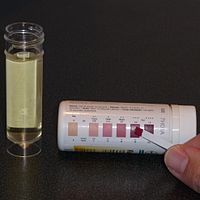
Photo from wikipedia
Changes in plasma levels of the main groups of cytokines and adipokines may correlate with the severity of metabolic disorders in hyperlipidemia and obesity. The aim of the study was… Click to show full abstract
Changes in plasma levels of the main groups of cytokines and adipokines may correlate with the severity of metabolic disorders in hyperlipidemia and obesity. The aim of the study was to assess the significance of ghrelin, leptin, their ratio (L/Gh), and the cytokine profile as biomarkers at dietary-induced hyperlipidemia. Material and methods. We used 48 female Wistar rats with an initial body weight of 123±1 g, which were divided into 6 groups. Group 1 (control) received a balanced semi-synthetic diet according to AIN93; group 2 - diet with excess fat (30% by weight); group 3 - a diet with the addition of 20% fructose solution instead of drinking water, group 4 - a diet with excess fat and fructose, group 5 - a diet with added cholesterol (0.5%), group 6 - a diet with cholesterol and fructose. On the 64th day of the experiment, the mass of internal organs was determined; the levels of cytokines and adipokines in blood plasma were measured by multiplex immunoassay. Results and discussion. A decrease in the level of leptin was found in group 5 compared with the control and with groups 2, 4 and 6 groups (p<0.05). The lowest level of ghrelin was found in group 2 (p<0.05) against the background of high concentrations of leptin. Significant correlations were found between L/Gh and the total mass of animals (r=0.321; р=0.034), the relative mass of adipose tissue (r=0.439; р=0.003) and with the relative mass of the spleen (r=-0.460; р=0.003). In group 2, at the maximum L/Gh ratio, a significantly higher weight of adipose tissue was found, whereas in groups 3 and 5, at the lowest L/Gh ratio, the relative amount of total fat was the lowest. L/Gh ratio correlated with the level of monocyte chemotactic protein-1 (MCP-1), RANTES, IL-18 and macrophage colony-stimulating factor (M-CSF). The concentrations of IL-17, IL-18, IL-4, IL-5, MIP-3a, IFN-γ, M-CSF and RANTES in the experimental groups were reduced compared with the control, with the most pronounced effect in group 5 together with the lowest L/Gh ratio. Conclusion. The presence of a significant correlation between L/Gh ratio and changes in the weight of rats' body, spleen, adipose tissue, as well as levels of cytokines involved in inflammation regulation, confirms the importance of L/Gh ratio as a biomarker in an in vivo model of dyslipidemia.
Journal Title: Voprosy pitaniia
Year Published: 2019
Link to full text (if available)
Share on Social Media: Sign Up to like & get
recommendations!